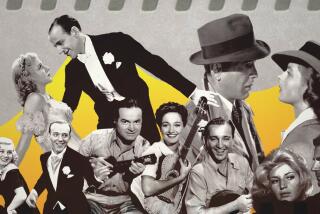Channeling the past, when TVs were still the future
Flat screens and plasma televisions notwithstanding, TVs are appliances now, as easy to take for granted as a refrigerator or stove. But back in the medium’s infancy, sets were often objects of beauty, always objects of wonder, and that’s how they were sold.
In “Window to the Future: The Golden Age of Television Marketing and Advertising” (Chronicle Books, $18.95), Steve Kosareff’s annotated picture book of vintage TV set advertisements, the wording of the ads is as quaint and amusing as the photographs and drawings that depict slender women in formal gowns and men in tuxedos awaiting the arrival of similarly chic friends for an evening of watching “Your Show of Shows,” “Somerset Maugham TV Theatre” or -- who knows? -- “Wrestling From Columbia Park.”
“Your guests arrive,” a full-page ad for Zenith’s 1951 Black Magic cabinet model begins. “You try to look not too obviously proud as you switch on your new Zenith. Conversation ripples to a whisper.
“Then -- a flood of excited comment. ‘I can scarcely believe what I’m seeing!’ ‘I had no idea television could be so big and real!’ ‘It’s so wonderfully clear and steady.’
“Then comes the magic moment! Never leaving your easy chair, you change programs with Zenith’s ‘Lazy Bones,’ the amazing remote control that fits in your palm.’
“ ‘It’s sheer Black Magic!’ someone exclaims.”
So it all must have seemed, especially considering that television was foreseen long before it was watched. As Kosareff notes in his text, visionaries such as Jules Verne and Albert Robida imagined such a medium, right down to the home-shopping channels, as early as the 1870s. It was literally a dream come true.
Kosareff’s book reproduces several TV-envisioning covers of 1920s magazines, such as Radio News and Radio-Craft, and a few cartoons about the medium. But the bulk of its 176 pages are devoted to glossy 1950s and ‘60s magazine ads designed to convince Americans that any and all TV was “must-see.”
Early ads such as the aforementioned one are particularly funny given how casual our relationship with the tube quickly became. There’s not an undershirt or a frumpy bathrobe in sight. Glamour dominated the big sell initially -- as well as celebrity. Seeing George Burns or Bob Hope endorsing sets is no surprise. But look on Page 102: There are Richard Rodgers and Oscar Hammerstein.
We had to be carefully taught, and the ad industry was there to do it with images that at first emphasized status and, later, family togetherness.
“Give your family a new thrill this Christmas morning,” suggests a mid-’50s Motorola ad that depicts two children ignoring the toys around them as they sit raptly at the feet of a new console.
And note the phrase “new thrill.” As millions acquired sets, the pitch emphasis was refocused on improvements and extras, including color (the grail of ‘50s videophiles) and a Glare-Ban tube that made viewing easier on the eyes.
“Window to the Future” reminds us how quickly TV altered our lifestyles. A 1949 cover of the New Yorker depicts a man carving a Thanksgiving turkey for his family while eyeing a football game on a tabletop TV. The one thing the book’s ads and cartoons didn’t anticipate was television’s effect on our attention spans. Many of the TV ads include a couple of hundred words of text.
Who was writing the copy? Tolstoy?
Many of us today wouldn’t read that much even if we did have the time.
More to Read
Sign up for our Book Club newsletter
Get the latest news, events and more from the Los Angeles Times Book Club, and help us get L.A. reading and talking.
You may occasionally receive promotional content from the Los Angeles Times.







